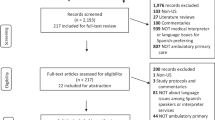Abstract
OBJECTIVE: To examine the effect of Spanish interpretation method on satisfaction with care.
DESIGN: Self-administered post-visit questionnaire.
SETTING: Urban, university-affiliated walk-in clinic.
PARTICIPANTS: Adult, English- and Spanish-speaking patients presenting for acute care of non-emergent medical problems.
MEASUREMENTS AND MAIN RESULTS: Satisfaction with overall clinic visit and with 7 provider characteristics was evaluated by multiple logistic regression, controlling for age, gender, ethnicity, education, insurance status, having a routine source of medical care, and baseline health. “Language-concordant” patients, defined as Spanish-speaking patients seen by Spanish-speaking providers and English-speaking patients, and patients using AT&T telephone interpreters reported identical overall visit satisfaction (77%; P=.57), while those using family or ad hoc interpreters were significantly less satisfied (54% and 49%; P<.01 and P=.007, respectively). AT&T interpreter use and language concordance also yielded similar satisfaction rates for provider characteristics (P>.2 for all values). Compared to language-concordant patients, patients who had family members interpret were less satisfied with provider listening (62% vs 85%; P=.003), discussion of sensitive issues (60% vs 76%; P=.02), and manner (62% vs 89%; P=.005). Patients who used ad hoc interpreters were less satisfied with provider skills (60% vs 83%; P=.02), manner (71% vs 89%; P=.02), listening (54% vs 85%; P=.002), explanations (57% vs 84%; P=.02), answers (57% vs 84%; P=.05), and support (63% vs 84%; P=.02).
CONCLUSIONS: Spanish-speaking patients using AT&T telephone interpretation are as satisfied with care as those seeing language-concordant providers, while patients using family or ad hoc interpreters are less satisfied. Clinics serving a large population of Spanish-speaking patients can enhance patient satisfaction by avoiding the use of untrained interpreters, such as family or ad hoc interpreters.
Similar content being viewed by others
References
Statistical Abstract of the United States 1999 117 ed. Washington, DC: US Bureau of the Census; 1999.
Blumenthal D. Part 1: Quality of care—what is it? N Engl J Med. 1996;335:891–4.
Harris LE, Luft FC, Rudy DW, Tierney WM. Correlates of health care satisfaction in inner-city patients with hypertension and chronic renal insufficiency. Soc Sci Med. 1995;41:1639–45.
Rubin HR, Gandek B, Rogers WH, Kosinski M, McHorney CA, Ware JE Jr. Patients’ ratings of outpatient visits in different practice settings. Results from the Medical Outcomes Study. JAMA. 1993;270:835–40.
Morales LS, Cunningham WE, Brown JA, Liu H, Hays RD. Are Latinos less satisfied with communication by health care providers. J Gen Intern Med. 1999;14:409–17.
Carrasquillo O, Orav EJ, Brennan TA, Burstin HR. Impact of language barriers on patient satisfaction in an emergency department. J Gen Intern Med. 1999;14:82–7.
Manson A. Language concordance as a determinant of patient compliance and emergency room use in patients with asthma. Med Care. 1988;26:1119–28.
Perez-Stable EJ, Napoles-Springer A, Miramontes JM. The effects of ethnicity and language on medical outcomes of patients with hypertension or diabetes. Med Care. 1997;35:1212–9.
Todd KH, Samaroo N, Hoffman JR. Ethnicity as a risk factor for inadequate emergency department analgesia. JAMA. 1993;269:1537–9.
Crane JA. Patient comprehension of doctor-patient communication on discharge from the emergency department. J Emerg Med. 1997;15:1–7.
Kuo D, Fagan MJ. Satisfaction with methods of Spanish interpretation in an ambulatory care clinic. J Gen Intern Med. 1999;14:547–50.
Hornberger JC, Gibson CD Jr., Wood W, et al. Eliminating language barriers for non-English speaking patients. Med Care. 1996;34:845–56.
Froehlich GW, Welch HG. Meeting walk-in patients’ expectations for testing. Effects on satisfaction. J Gen Intern Med. 1996;11:470–4.
Ware J Jr., Kosinski M, Keller SD. A 12-Item Short-Form Health Survey: construction of scales and preliminary tests of reliability and validity. Med Care. 1996;34:220–33.
Baker DW, Hayes R, Fortier JP. Interpreter use and satisfaction with interpersonal aspects of care for Spanish-speaking patients. Med Care. 1998;36:1461–70.
Derose KP, Hays RD, McCaffrey DF, Baker DW. Does physician gender affect satisfaction of men and women visiting the emergency department. J Gen Intern Med. 2001;16:218–26.
Author information
Authors and Affiliations
Corresponding author
Additional information
This research was funded by the Division of General Internal Medicine, University of Colorado Health Sciences Center.
Rights and permissions
About this article
Cite this article
Lee, L.J., Batal, H.A., Maselli, J.H. et al. Effect of spanish interpretation method on patient satisfaction in an urban walk-in clinic. J GEN INTERN MED 17, 641–646 (2002). https://doi.org/10.1046/j.1525-1497.2002.10742.x
Issue Date:
DOI: https://doi.org/10.1046/j.1525-1497.2002.10742.x




